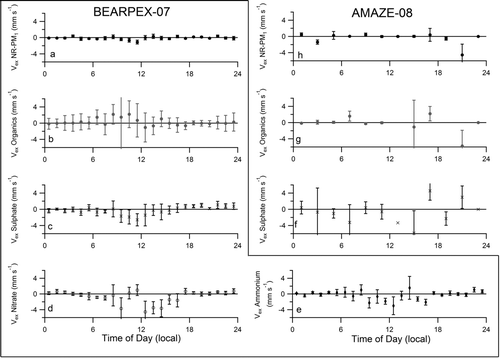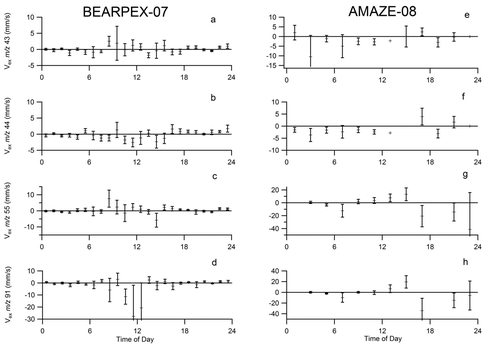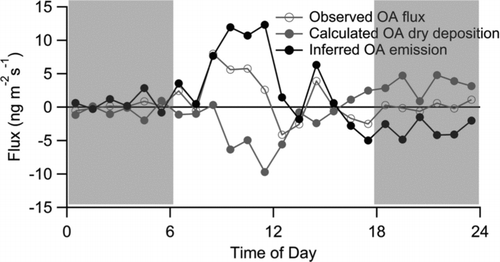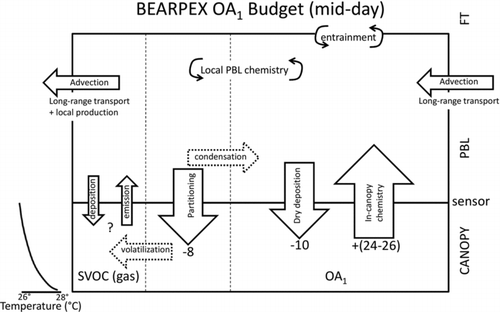Figures & data
![Figure 1 FIG. 1 Diel cycles (local time: PDT for BEARPEX-07, AST for AMAZE-08) of mass concentrations for NR-PM1 and the organic, sulfate, nitrate and ammonium components for the entire BEARPEX-07 campaign [(a and b)18 August to 28 September 2007] and the AMAZE-08 campaign [(c and d) 24 February to 13 March 2008]. Vertical bars indicate the standard error of the mean for the dataset. The diel cycles for NR-PM1 and ammonium from BEARPEX-07 are reproduced from Farmer et al. (Citation2011). Elevated concentrations at midnight may be due to local influences. Note the different scales between the various panels.](/cms/asset/b29351d2-1306-439e-a142-31eb263be67f/uast_a_791022_f0001_b.gif)




![Figure 6 FIG. 6 The mid-day submicron organic aerosol mass flux budget (ng m−2 s−1) between the canopy and planetary boundary layer (PBL) over the Amazon during the AMAZE-08 experiment. Submicron primary biological aerosol particles (PBAP1) are emitted (+3 ng m−2 s−1) from the forest, but also deposit at equal or lesser rates. In-canopy production of SOA is minor and challenging to constrain, but constitutes an emission source [<(4–41) ng m−2 s−1] from the forest. Dry deposition of organic aerosol (transported, locally and canopy-produced) is also predicted to be small (−2 ng m−2 s−1), though wet deposition may be substantial. The vertical thermal gradients typically observed in the Amazon canopy coupled with observed aerosol thermograms suggest that gas-particle partitioning along the vertical gradient produces an apparent upward flux (<8 ng m−2 s−1). Wet deposition estimates are substantial, but highly uncertain [<|−(11–98)| ng m−2 s−1]. Long-range transported organic aerosol (i.e., not originating from the Amazon and/or nonbiogenic sources) is advected into the Amazon PBL. Advection removes any transported or locally produced aerosol that has not been removed by wet or dry deposition. Unknown components of the OA1 flux budget include entrainment and fluxes of gas-phase semivolatile organic compounds.](/cms/asset/690cc4a3-0b05-4d34-8fce-59e1ed2386ce/uast_a_791022_f0006_b.gif)
Register now or learn more
Free access
![Figure 1 FIG. 1 Diel cycles (local time: PDT for BEARPEX-07, AST for AMAZE-08) of mass concentrations for NR-PM1 and the organic, sulfate, nitrate and ammonium components for the entire BEARPEX-07 campaign [(a and b)18 August to 28 September 2007] and the AMAZE-08 campaign [(c and d) 24 February to 13 March 2008]. Vertical bars indicate the standard error of the mean for the dataset. The diel cycles for NR-PM1 and ammonium from BEARPEX-07 are reproduced from Farmer et al. (Citation2011). Elevated concentrations at midnight may be due to local influences. Note the different scales between the various panels.](/cms/asset/b29351d2-1306-439e-a142-31eb263be67f/uast_a_791022_f0001_b.gif)




![Figure 6 FIG. 6 The mid-day submicron organic aerosol mass flux budget (ng m−2 s−1) between the canopy and planetary boundary layer (PBL) over the Amazon during the AMAZE-08 experiment. Submicron primary biological aerosol particles (PBAP1) are emitted (+3 ng m−2 s−1) from the forest, but also deposit at equal or lesser rates. In-canopy production of SOA is minor and challenging to constrain, but constitutes an emission source [<(4–41) ng m−2 s−1] from the forest. Dry deposition of organic aerosol (transported, locally and canopy-produced) is also predicted to be small (−2 ng m−2 s−1), though wet deposition may be substantial. The vertical thermal gradients typically observed in the Amazon canopy coupled with observed aerosol thermograms suggest that gas-particle partitioning along the vertical gradient produces an apparent upward flux (<8 ng m−2 s−1). Wet deposition estimates are substantial, but highly uncertain [<|−(11–98)| ng m−2 s−1]. Long-range transported organic aerosol (i.e., not originating from the Amazon and/or nonbiogenic sources) is advected into the Amazon PBL. Advection removes any transported or locally produced aerosol that has not been removed by wet or dry deposition. Unknown components of the OA1 flux budget include entrainment and fluxes of gas-phase semivolatile organic compounds.](/cms/asset/690cc4a3-0b05-4d34-8fce-59e1ed2386ce/uast_a_791022_f0006_b.gif)
Please note: Selecting permissions does not provide access to the full text of the article, please see our help page How do I view content?
To request a reprint or corporate permissions for this article, please click on the relevant link below:
Please note: Selecting permissions does not provide access to the full text of the article, please see our help page How do I view content?
Obtain permissions instantly via Rightslink by clicking on the button below:
If you are unable to obtain permissions via Rightslink, please complete and submit this Permissions form. For more information, please visit our Permissions help page.
People also read lists articles that other readers of this article have read.
Recommended articles lists articles that we recommend and is powered by our AI driven recommendation engine.
Cited by lists all citing articles based on Crossref citations.
Articles with the Crossref icon will open in a new tab.